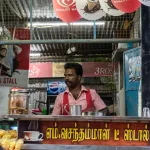The global supply chain, that marvel of modern efficiency which once moved 12 per cent of global trade through the Red Sea with clockwork precision, is committing ritual suicide.
Not through some grand strategic blunder, but through the accumulated weight of a thousand small cuts: AI-driven automation that promises productivity but delivers fragmentation, geopolitical tensions that turn shipping routes into minefields, and a growing realisation that the pursuit of ever-greater efficiency has created a system so brittle it shatters at the first sign of stress.
The automation paradox
Consider the curious case of supply chain robotics, where robots were projected to displace 85 million jobs by 2025—a figure that now seems quaint given the exponential advances in AI.
The promise is seductive: fully automated warehouses, ‘dark facilities’ operating without human intervention, and supply chains that anticipate demand before consumers know they want something. Yet this technological revolution is fragmenting the very networks it seeks to optimise.
The morphing of information technology to industrial robotics will be rapid in the next decade and enterprises must be prepared to avoid an existential crisis, warns industry analysis. But the existential crisis is already here, hidden in plain sight. As companies rush to deploy AI agents and autonomous systems, they are inadvertently creating supply chains that speak different languages, operate on incompatible protocols, and require ever more complex orchestration to function as a whole.
The irony is perfect. In their pursuit of efficiency, logistics companies are building systems so sophisticated they require armies of specialists to maintain them, so automated they cannot adapt to unexpected circumstances, and so optimised for specific scenarios they fail catastrophically when those scenarios change—which, in today’s world, happens roughly every Tuesday.
The Red Sea riddle
Nowhere is this brittleness more evident than in the ongoing chaos surrounding Middle Eastern shipping routes. Attacks on vessels in the Red Sea, a vital artery, have led to a significant drop in traffic, forcing companies to reroute around the Cape of Good Hope—a longer and more expensive route that can add up to 10 extra days to transit times.
And this before the current outbreak of hostilities in the Middle East that now threatens to see Iran close the Straits of Hormuz that link the Persian Gulf to the Arabian Sea.
This disruption is merely the most visible symptom of a deeper problem: the weaponisation of global logistics. Conflicts in the Middle East are increasingly ‘transnational’, spreading beyond national borders and becoming intertwined with regional and global trade, creating what one expert describes as supply chains that “fuel transnational conflict.”
Meanwhile, the United States has imposed sanctions on nearly two dozen firms operating in virtually every aspect of Iran’s illicit international oil trade, creating a cat-and-mouse game of shell companies, shadow fleets, and complex and often less efficient trade routes, including multiple ship-to-ship transfers to obscure cargo origin. The result is not just higher costs, but a fundamental erosion of the transparency and predictability upon which global commerce depends.
The eastern promise
Into this chaos steps Central and Eastern Europe, positioning itself as both beneficiary and potential solution to supply chain disruption. Countries in the region are increasingly leveraging their geographic, economic, and talent advantages to become crucial nodes in a range of industries, with 2025 already shaping up to be a transformative year for infrastructure investment across the region.
The numbers tell the story of a region seizing its moment. Polish-Ukrainian rail transport has seen remarkable growth—a 28 per cent increase in cargo volumes in early 2024 compared to 2023, while LG Chem’s decision to establish a major EV battery plant in Poland—the largest in Europe—underscores the region’s growing importance in the automotive industry’s shift towards sustainability.
But perhaps the most intriguing development is the emergence of the Middle Corridor, linking Chinese and European markets via Central Asia and the Caucasus. The World Bank suggests this route could triple trade volumes while halving travel time along the route by 2030—a projection that seems almost absurdly optimistic given the region’s political complexities.
The Caucasus calculation
The geopolitical arithmetic of the Caucasus and Central Asia reveals the fundamental tension at the heart of modern supply chains: the trade-off between efficiency and resilience. The geopolitical tensions and economic disruptions unleashed by the Russian invasion of Ukraine in February 2022 created new opportunities and challenges for transport corridors through the Caucasus and Central Asia, forcing a recalculation of routes that had been stable for decades.
The Middle Corridor, also known as the Trans-Caspian International Transport Route (TITR), has become increasingly important as the EU seeks to reduce its reliance on routes controlled by Russia and diversify both its trade and energy supply chains. Yet this diversification comes at a cost: longer routes, higher expenses, and the need to build entirely new infrastructure and relationships.
The region’s strategic importance extends beyond mere geography. Countries like Kazakhstan, already the world’s largest producer of uranium, boast rich deposits of titanium, zinc, and gold, while Ukraine possesses one of Europe’s largest titanium reserves, essential for defence and aerospace manufacturing. The United States is already eyeing these resources as alternatives to Chinese supply chains, setting the stage for a new great game played out in shipping manifests and trade agreements.
The resilience reckoning
What emerges from this tangle of technological promise and geopolitical reality is a sobering truth: the supply chain industry is in the process of reinventing itself in ways that may ultimately undermine the very qualities that made it valuable in the first place.
Many countries of the Caucasus and Central Asia have been experiencing the impacts of various shocks, including the Covid-19 pandemic, climate change-inflicted disasters, and geopolitical conflicts, yet the region is averaging relatively high growth of around 2.5 per cent.
This resilience, however, comes at a price. A survey last year of global supply chain leaders suggested that 62 per cent of respondents feel large-scale supply chain disruptions are likely to be a recurring challenge for the foreseeable future, leading companies to build redundancy into systems that were previously optimised for lean efficiency.
The result is a peculiar form of corporate cognitive dissonance: executives simultaneously pursuing AI-driven automation to reduce costs while spending billions on backup systems and alternative routes to manage the risks that automation cannot address.
The seppuku solution
Perhaps the most honest assessment comes from those who recognise that the old model is already dead. Global supply chains are on a growth trajectory due to increased consumption and population, yet with this change comes a need to enhance production and improve planning, execution, collaboration and performance efficiency. The challenge is not to preserve what exists, but to build something entirely new.
The seppuku metaphor is apt not because the supply chain industry is dying, but because it is deliberately dismantling the structures that brought it success in order to survive in a more complex world. The ritual suicide of hyper-efficiency may be the price of long-term survival in an age where the greatest risk is not higher costs, but catastrophic failure.
Whether this transformation succeeds will depend not on the sophistication of the algorithms or the speed of the robots, but on the unglamorous work of building institutions, relationships, and redundancies that can withstand the next shock—and the one after that.
In a world where supply chains have become instruments of statecraft and targets of warfare, the greatest innovation may be learning, once again, how to do business with people rather than just algorithms.
The supply chain of the future will be slower, more expensive, and far more complex than what came before. But it might just survive the next crisis. And in a world where survival trumps optimisation, that may be the best anyone can hope for.







